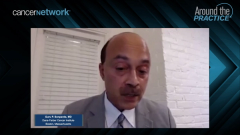
Overview of Advanced Urothelial Carcinoma
Neeraj Agarwal, MD, leads the discussion on the typical patient presentation and major risk factors for urothelial cancer.
Episodes in this series

Petros Grivas, MD, PhD: Hello, everybody. Thank you for joining. Welcome to this CancerNetwork® presentation titled, “Around the Practice: Advanced Urothelial Carcinoma.” I am your host, Dr Petros Grivas. I’m a medical oncologist at Seattle Cancer Care Alliance and an associate professor at the University of Washington Fred Hutchinson Cancer Research Center in Seattle. I’m very excited because joining me are Dr Guru Sonpavde, the director of the urothelial cancer program at Dana-Farber Cancer Institute and an associate professor of medicine at Harvard Medical School in Boston, Massachusetts. Guru, thanks for joining us.
Guru P. Sonpavde, MD: Thank you, Petros.
Petros Grivas, MD, PhD: Also joining us is Professor Tom Powles. He is the director of the Barts Cancer Institute and a professor of genitourinary oncology in London, England, and we’re superexcited. Tom, I know it’s late in London. Thanks for joining us.
Thomas Powles, MBBS, MRCP, MD: I’m excited to be here with you.
Petros Grivas, MD, PhD: Thank you, Tom. Joining us also is Dr Neeraj Agarwal, who is senior director of research innovation at Huntsman Cancer Institute and a professor of oncology at the University of Utah School of Medicine in Salt Lake City. Thanks, Neeraj, for joining us.
Neeraj Agarwal, MD: My pleasure. Thanks for having me.
Petros Grivas, MD, PhD: Thank you, Neeraj. We’re going to discuss the treatment landscape for locally advanced unresectable and metastatic urothelial carcinoma specifically in the first-line setting. There are so many data to cover. We’re going to review a couple of patient cases and involve our audience by using an interactive online platform to answer several polling questions that will then be discussed by our panelists. Let’s begin.
For the first polling question, I want to make sure everybody here describes their specialty: medical oncology, general medical oncology, genitourinary oncology, radiation oncology, urology, or other. Please vote. We’ll give you about 15 seconds. We have a balance between medical oncologists who see multiple tumor types and GU [genitourinary] medical oncologists, so I suppose this may be a surrogate marker of academic vs community practice. We also have about half who are other specialties. Thank you for joining.
The second question: What percentage of your patients have locally advanced or metastatic urothelial cancer? I’m referring to patients who have tumor that’s not amenable to curative intent therapy. It’s unresectable surgically or not amenable to curative intent radiation therapy. Please vote. Again, 15 seconds. And as we prepare for the first long discussion, we’re going to get a sense. It sounds like of the responders so far, between 30% and 40% of their practices are patients with advanced urothelial cancer. Actually, it’s two-thirds, and one-third says under 10%.
Thank you, everyone, for voting. I would like to start here. Dr Agarwal, why don’t we start with you? If can you describe the major risk factors for urothelial cancer? In the same context, can you describe a typical patient in terms of the risk factors, gender, age, and presentation type?
Neeraj Agarwal, MD: The most common risk factor is being a man. A white man in America is at a much higher risk compared with a Hispanic man or an African American man. That’s the first thing I tell my trainees. The second risk factor, obviously, which is the most recognized risk factor from the environmental perspective, is smoking. Smoking remains the most common cause of metastatic or superficial bladder cancer in our patients. Once we go beyond these 2 most recognized risk factors, there’s a long list of hydrocarbons. It’s hard to keep up with those names, complicated chemical names, which can cause bladder cancer. It really depends on the job and background of the patients, what job they were involved in. Miners, for example, or patients working in some typical fields of operations, getting exposed to those hydrocarbons. We also know in countries like Egypt where a different type of bladder cancer is associated with a worm infection, schistosomiasis—if I am pronouncing it right. Those are the risk factors I keep in mind, but I’ll come back to smoking and being a man, which are the 2 most common risk factors.
Petros Grivas, MD, PhD: Thank you, Neeraj. And as you said, the median age of diagnosis is 73 years old, but we have to make sure we do the proper work-up even in younger patients. Tom, what portion of your patients in your practice in Barts Cancer Institute present with metastatic disease vs earlier disease states?
Thomas Powles, MBBS, MRCP, MD: Perhaps 1 of the differences between bladder cancer and some of the other cancers I treat is there does seem to be this progression from early phase disease to later phase disease, and it’s not uncommon for a patient to have had T1 or TA, CIS [carcinoma in situ], transferring to T2, then N1, then M1 disease. Actually, a minority of patients arrive with widespread metastatic disease. Most patients have been worked up with local disease that then progresses, which is 1 of the challenges that we face with urothelial cancer. Many of the patients have had a long journey, but we don’t seem to be curing as many as we would like.
Petros Grivas, MD, PhD: Thank you, Tom. I agree. We have the same pattern. Could you also comment a little on the prognostic factors in the first-line setting? Do you use the Bajorin criteria? Any other prognostic factors for patients with metastatic disease?
Thomas Powles, MBBS, MRCP, MD: There are 2 important prognostic factors that are really outstanding that keep coming up. The performance status of the patient is important, and cancer-related symptoms associated with inability to perform daily functions. That’s associated with a bad prognosis. The other key factor seems to be the presence of visceral metastases, so liver metastases and bone metastases patients do poorly. We know that patients with lymph node–only disease do quite well, and that seems to be irrespective of what treatment patients receive. It’s not just the immunotherapy patients who do well with those, which is relevant. There’s been this issue around renal function and whether that’s associated with poor outcome—perhaps we’ll talk about that a bit later—and cisplatin eligibility. Of course, there are other factors that keep coming up, like albumin, and that seems to be in a number of the prognostic factors’ indices. But essentially performance status and visceral metastases are the 2 powerful drivers for me.
Petros Grivas, MD, PhD: Thank you, Tom. We had a recent paper that I want to share with you that we looked at the first-line setting, specifically in patients who started with immunotherapy with Dr. Okazaki and others. We saw an ECOG PS [performance status] of 2 or higher, liver metastases—the things you just mentioned, Tom. In addition, a high neutrophil-to-lymphocyte ratio, more than 5, and low albumin, less than 3.5 g/dL, would come to be prognostic. Obviously, this needs a validation, but it seems to validate the previous data from Dr Bajorin and colleagues.
Transcript edited for clarity.
Newsletter
Stay up to date on recent advances in the multidisciplinary approach to cancer.

























































































